Integrating the Living Wall with Mechanical Ventilation to Improve Indoor Thermal Environment in the Transition Season
Abstract
1. Introduction
2. Materials and Methods
2.1. Description of the LW-V System
2.2. Description of Experimental Platform
2.3. Description of Experimental Test Methods
- Before the survey, the subjects were required to arrive at the experimental site in advance and spend 10 min outdoors for relaxation. During this time, the subjects received a comprehensive introduction to the experimental process and related precautions, completed basic personal information forms, and then underwent random assignment to either Room A or Room B.
- Prior to commencing the experiment, skin temperature monitor probes were affixed onto each subject’s skin surface.
- The subjects remained in a state of tranquility within either Room B or Room A for a duration of 30 min. The subjects’ skin temperature was continuously monitored, and they were instructed to complete the questionnaire at 10 min intervals. Throughout this period, the subjects were allowed to engage in activities such as reading and using mobile phones and other electronic devices.
2.4. Description of Questionnaire Research Method
3. Results
3.1. Analysis of Indoor Environment Monitoring Results
3.2. Analysis of Skin Temperature Monitoring Results
3.3. Analysis of Subjective Questionnaire Survey Results
4. Conclusions
- (1)
- During the transitional season, the LW-V system played a pivotal role in enhancing the indoor thermal environment. It effectively reduced the average room temperature by 1.45 °C, increased relative humidity by 19.1%, regulated indoor air speed to within the range of 0.2–0.65 m/s, and slightly decreased CO2 concentration levels.
- (2)
- During the transition season, the LW-V system was able to improve the subjects’ skin temperature, decreasing the subject’s mean skin temperature by 0.18 °C to closer to the neutral mean skin temperature of 33.2 °C.
- (3)
- During the transition season, subjects rated Room B higher than Room A. To compare, during the experimental period, in Room B there was an overall thermal sensation vote of −0.51 (between “Neutral (0)” and “Slightly cool (−1)”) and an overall humid sensation vote of −0.18 (close to “Neutral (0)”); the overall indoor air speed sensation vote was 1.31, which was close to “Slight air speed (+1)”; the subjects rated the room freshness at 0.8 (closed to “Fresh (+1)”); and the overall thermal comfort vote was 0.3 (between “Neutral (0)” and “Slightly comfortable (+1)”), with a gradual upward trend in voting results over time.
Author Contributions
Funding
Institutional Review Board Statement
Informed Consent Statement
Data Availability Statement
Conflicts of Interest
References
- Zhao, P.J.; Zhang, M.Z. The impact of urbanisation on energy consumption: A 30-year review in China. Urban Clim. 2018, 24, 940–953. [Google Scholar] [CrossRef]
- Liu, S.H.; Ge, W.Y.; Meng, X. Influence of the shading nets on indoor thermal environment and air-conditioning energy consumption in lightweight buildings. Energy Rep. 2024, 11, 4515–4521. [Google Scholar] [CrossRef]
- Rentschler, J.; Leonov, N. Global air pollution exposure and poverty. Nat. Commun. 2023, 14, 4432. [Google Scholar] [CrossRef] [PubMed]
- Pérez-Urrestarazu, L.; Fernández-Cañero, R.; Franco-Salas, A.; Egea, G. Vertical Greening Systems and Sustainable Cities. J. Urban Technol. 2015, 22, 65–85. [Google Scholar] [CrossRef]
- Yi, F.; Yang, X.X.; Yang, R.Y.; Zhao, M.M.; Dong, Y.M.; Li, L.; He, Y.F.; Guo, M.M.; Li, J.; Zhang, X.H.; et al. A cross-sectional study of Chinese women facial skin status with environmental factors and individual lifestyles. Sci. Rep. 2022, 12, 18110. [Google Scholar] [CrossRef] [PubMed]
- Hamehkasi, M. Effects of Low Humidity on Comfort, Health, and Indoor Environmental Quality: Literature Review. Master’s Thesis, Kansas State University, Manhattan, KS, USA, 2016. [Google Scholar]
- Ge, L.M.; Gao, Y.; Meng, X. Employing the spray system to alleviate the thermal action of air-conditioning in summer. Case Stud. Therm. Eng. 2024, 55, 104133. [Google Scholar] [CrossRef]
- Agha-Hossein, M.M.; El-Jouzi, S.; Elmualim, A.A.; Ellis, J.; Williams, M. Post-occupancy studies of an office environment: Energy performance and occupants’ satisfaction. Build. Environ. 2013, 69, 121–130. [Google Scholar] [CrossRef]
- Liu, F.D.; Yan, L.Y.; Meng, X. A review on indoor green plants employed to improve indoor environment. J. Build. Eng. 2022, 53, 104542. [Google Scholar] [CrossRef]
- Deng, L.J.; Deng, Q.H. The basic roles of indoor plants in human health and comfort. Environ. Sci. Pollut. Res. 2018, 25, 36087–36101. [Google Scholar] [CrossRef]
- Fernández-Cañero, R.; Urrestarazu, L.P.; Franco, S.A. Assessment of the cooling potential of an indoor living wall using different substrates in a warm climate. Indoor Built Environ. 2012, 21, 642–650. [Google Scholar] [CrossRef]
- Pérez-Urrestarazu, L.; Fernández-Cañero, R.; Franco, A.; Egea, G. Influence of an active living wall on indoor temperature and humidity conditions. Ecol. Eng. 2016, 90, 120–124. [Google Scholar] [CrossRef]
- Meng, X.; Yan, L.Y.; Liu, F.D. A new method to improve indoor environment: Combining the living wall with air-conditioning. Build. Environ. 2022, 216, 108981. [Google Scholar] [CrossRef]
- Smith, A.; Pitt, M. Healthy workplaces: Plantscaping for indoor environmental quality. Facilities 2011, 29, 169–187. [Google Scholar] [CrossRef]
- Ding, N.; Liu, F.D.; Pang, F.; Su, J.Y.; Yan, L.Y.; Meng, X. Integrating the living wall with the split air conditioner towards indoor heating environment improvement in winter. Case Stud. Therm. Eng. 2023, 47, 103061. [Google Scholar] [CrossRef]
- Rodgers, K.; Handy, R.; Hutzel, W. Indoor air quality (IAQ) improvements using biofiltration in a highly efficient residential home. J. Green Build. 2013, 8, 22–27. [Google Scholar] [CrossRef]
- Tudiwer, D.; Korjenic, A. The effect of an indoor living wall system on humidity, mould spores and CO2-concentration. Energy Build. 2017, 146, 73–86. [Google Scholar] [CrossRef]
- Torpy, F.R.; Irga, P.J.; Burchett, M.D. Profiling indoor plants for the amelioration of high CO2 concentrations. Urban For. Urban Green. 2014, 13, 227–233. [Google Scholar] [CrossRef]
- Shao, Y.M.; Li, J.Q.; Zhou, Z.W.; Hu, Z.Y.; Zhang, F.; Cui, Y.L.; Chen, H.J. The effects of vertical farming on indoor carbon dioxide concentration and fresh air energy consumption in office buildings. Build. Environ. 2021, 195, 0360–1323. [Google Scholar] [CrossRef]
- Han, K.T. Influence of Limitedly Visible Leafy Indoor Plants on the Psychology, Behavior, and Health of Students at a Junior High School in Taiwan. Environ. Behav. 2009, 41, 658–692. [Google Scholar] [CrossRef]
- Jo, H.; Song, C.; Miyazaki, Y. Physiological Benefits of Viewing Nature: A Systematic Review of Indoor Experiments. Int. J. Environ. Res. Public Health 2019, 16, 4739. [Google Scholar] [CrossRef]
- Yin, J.; Yuan, J.; Arfaei, N.; Catalano, P.J.; Allen, J.G.; Spengler, J.D. Effects of biophilic indoor environment on stress and anxiety recovery: A between-subjects experiment in virtual reality. Environ. Int. 2020, 136, 105427. [Google Scholar] [CrossRef] [PubMed]
- Lee, M.S.; Lee, J.; Park, B.J.; Miyazaki, Y. Interaction with indoor plants may reduce psychological and physiological stress by suppressing autonomic nervous system activity in young adults: A randomized crossover study. J. Physiol. Anthropol. 2015, 34, 21. [Google Scholar] [CrossRef] [PubMed]
- Gonzalez, M.T.; Hartig, T.; Patil, G.G.; Martinsen, E.W.; Kirkevold, M. Therapeutic horticulture in clinical depression: A prospective study. Res. Theory Nurs. Pract. 2009, 23, 312–328. [Google Scholar] [CrossRef] [PubMed]
- Meng, X. Influence of Air-Conditioning Intermittent Operation on the Cooling Load from Opaque Envelopes in Residences. Case Stud. Therm. Eng. 2024, 58, 104393. [Google Scholar] [CrossRef]
- Han, A.R.; Park, S.A.; Ahn, B.E. Reduced stress and improved physical functional ability in elderly with mental health problems following a horticultural therapy program. Complement. Ther. Med. 2018, 38, 19–23. [Google Scholar] [CrossRef] [PubMed]
- Oh, Y.A.; Kim, S.O.; Park, S.A. Real Foliage Plants as Visual Stimuli to Improve Concentration and Attention in Elementary Students. Int. J. Environ. Res. Public Health 2019, 16, 796. [Google Scholar] [CrossRef] [PubMed]
- Van den Berg, A.E.; Wesselius, J.E.; Maas, J.; Tanja-Dijkstra, K. Green Walls for a Restorative Classroom Environment: A Controlled Evaluation Study. Environ. Behav. 2017, 49, 791–813. [Google Scholar] [CrossRef]
- Danielski, I.; Svensson, A.; Weimer, K.; Lorentzen, L.; Warne, M. Effects of Green Plants on the Indoor Environment and Wellbeing in Classrooms—A Case Study in a Swedish School. Sustainability 2022, 14, 3777. [Google Scholar] [CrossRef]
- Lohr, V.I.; Pearson-Mims, C.H.; Goodwin, G.K. Interior Plants May Improve Worker Productivity and Reduce Stress in a Windowless Environment. J. Environ. Hort. 1996, 14, 97–100. [Google Scholar] [CrossRef]
- Hähn, N.; Essah, E.; Blanusa, T. Biophilic design and office planting: A case study of effects on perceived health, well-being and performance metrics in the workplace. Intell. Build. Int. 2020, 13, 241–260. [Google Scholar] [CrossRef]
- Yıldırım, K.; Hidayetoğlu, M.L.; Ozkan, A. The Impacts of Indoor Plants on Participants Perceptual Evaluations. J. Art Arc. Stud. 2020, 9, 30–38. [Google Scholar]
- Kim, J.; Cha, S.H.; Koo, C.; Tang, A.K. The effects of indoor plants and artificial windows in an underground environment. Build. Environ. 2018, 138, 53–62. [Google Scholar] [CrossRef]
- Brilli, F.; Fares, S.; Ghirardo, A.; Visser, P.D.; Calatayud, V.; Muñoz, A.; Annesi-Maesano, I.; Sebastiani, F.; Alivernini, A.; Varriale, V.; et al. Plants for sustainable improvement of indoor air quality. Trends Plant Sci. 2018, 23, 507–512. [Google Scholar] [CrossRef] [PubMed]
- Ding, N.; Liu, F.D.; Ding, X.L.; Yan, L.Y.; Meng, X. Effect of Lighting Environment on the CO2 Concentration Reduction Efficiency of Plants by a Model Experiment. Buildings 2022, 12, 1848. [Google Scholar] [CrossRef]
- Song, J.W. Study on the Influence of Architectural Space Scale on Human Thermal Comfort. Master’s Thesis, Tianjin University, Tianjin, China, 2017. [Google Scholar]
- Wang, X.D. Study on the Matching Relation Between Indoor Thermal Environment and Bed Climate Based on Partial Body Thermal Demands. Ph.D. Thesis, Xi’an University of Architecture and Technology, Xi’an, China, 2016. [Google Scholar]
- Xiong, J.; Ma, T.; Lian, Z.W.; Dear, R.D. Perceptual and physiological responses of elderly subjects to moderate temperatures. Build. Environ. 2019, 156, 117–122. [Google Scholar] [CrossRef]
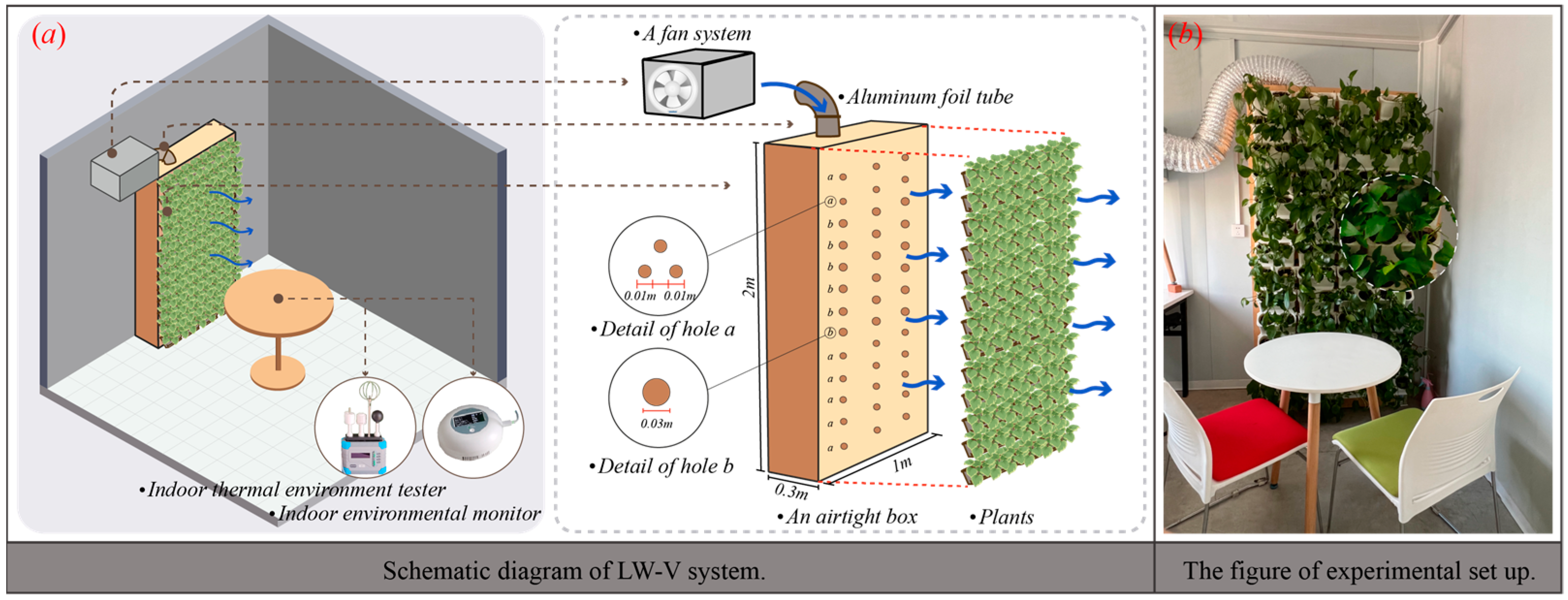



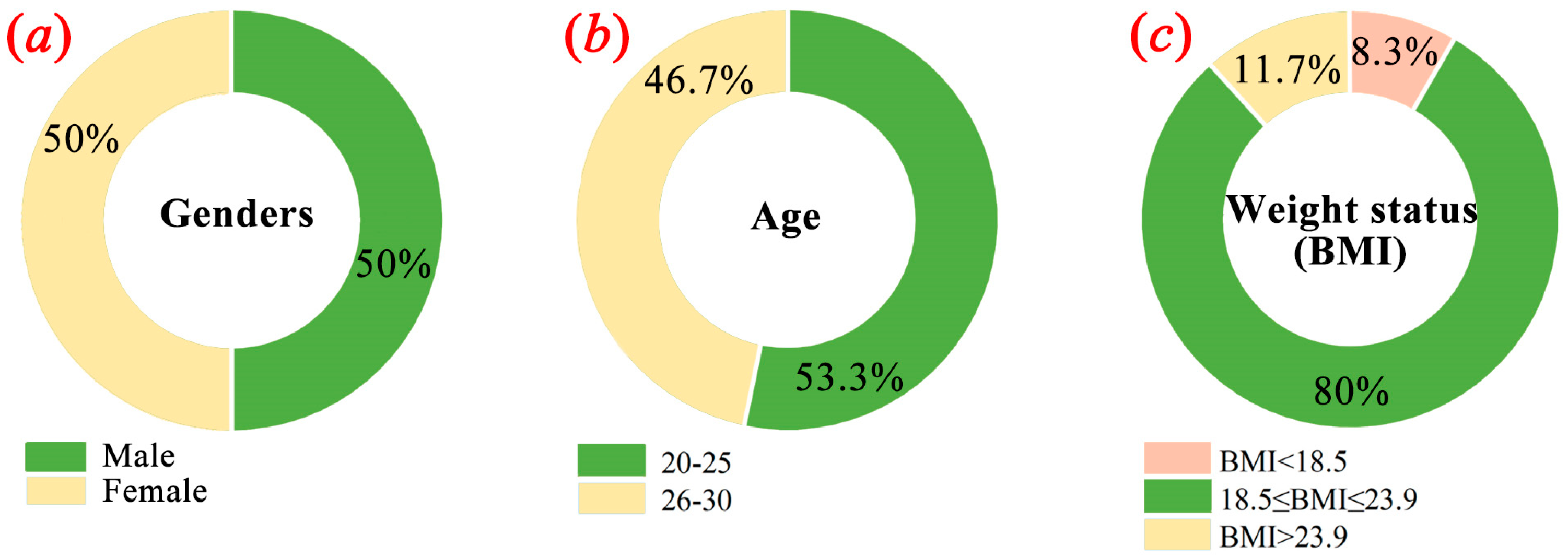
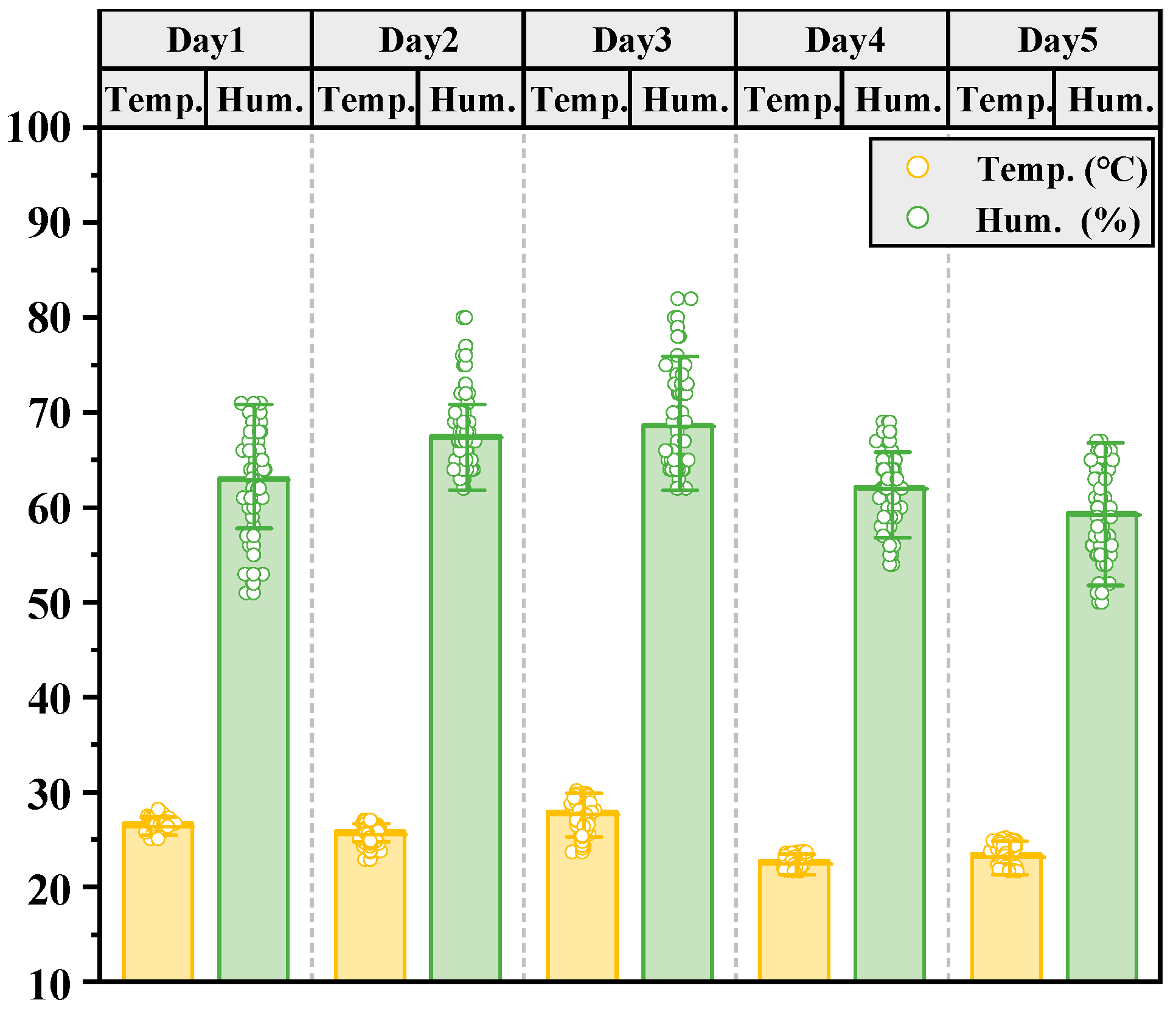
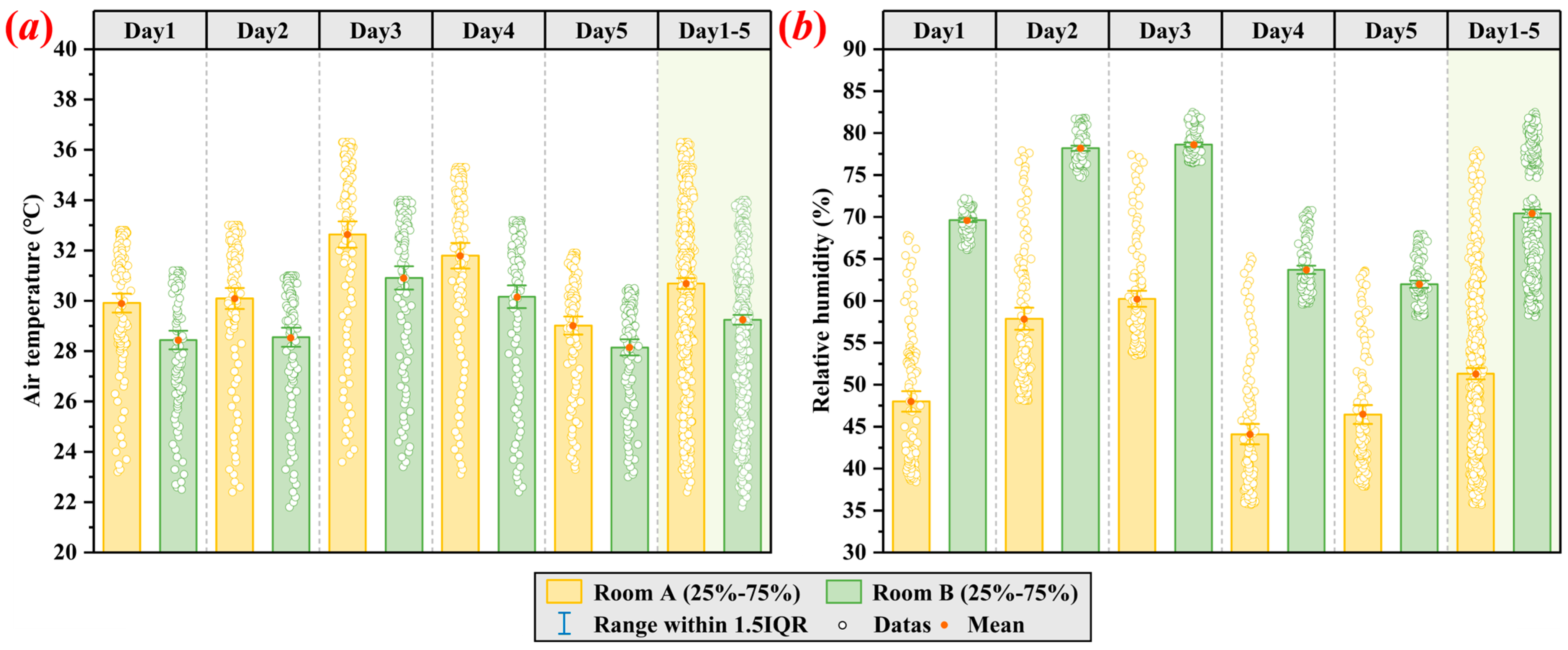
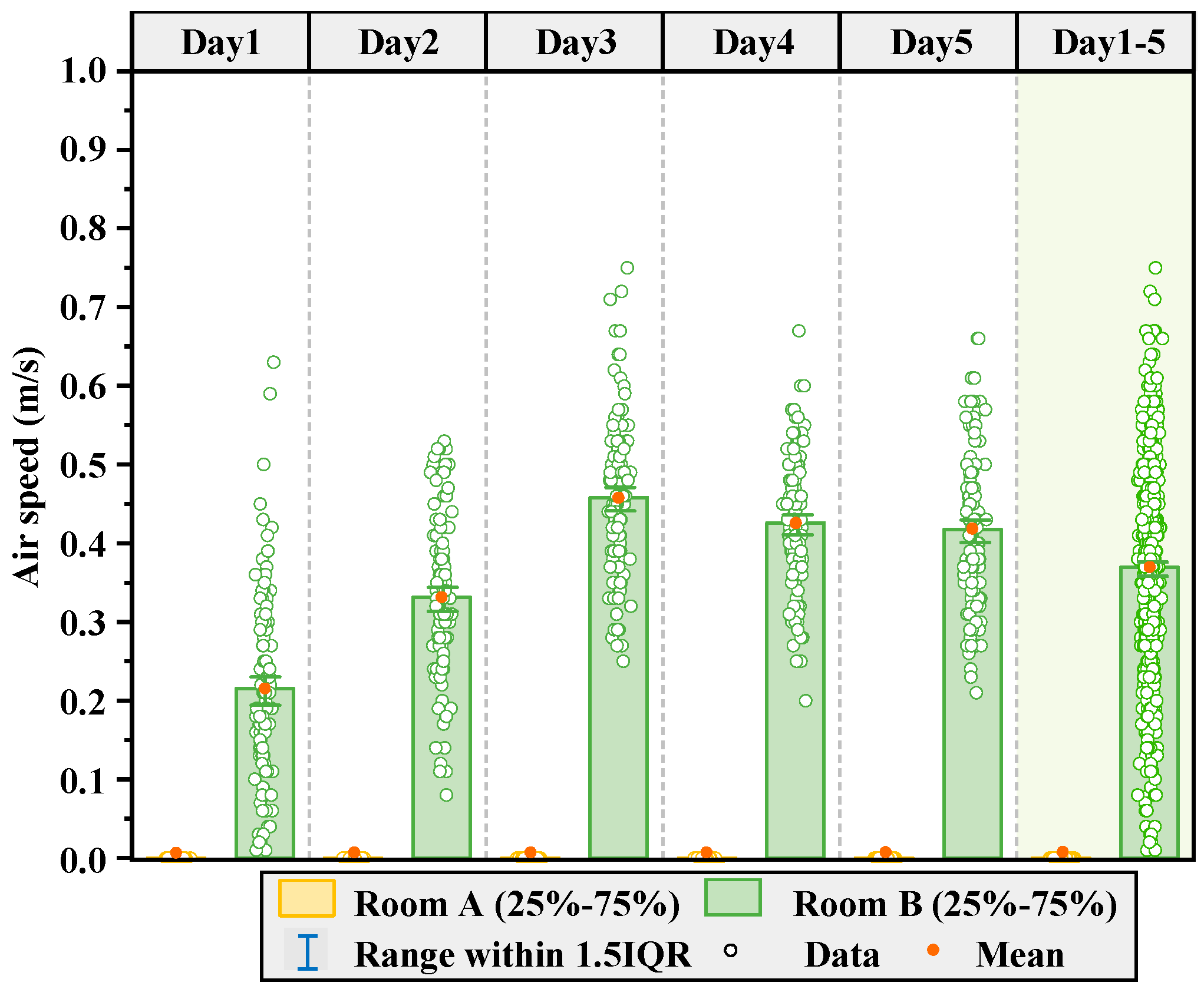
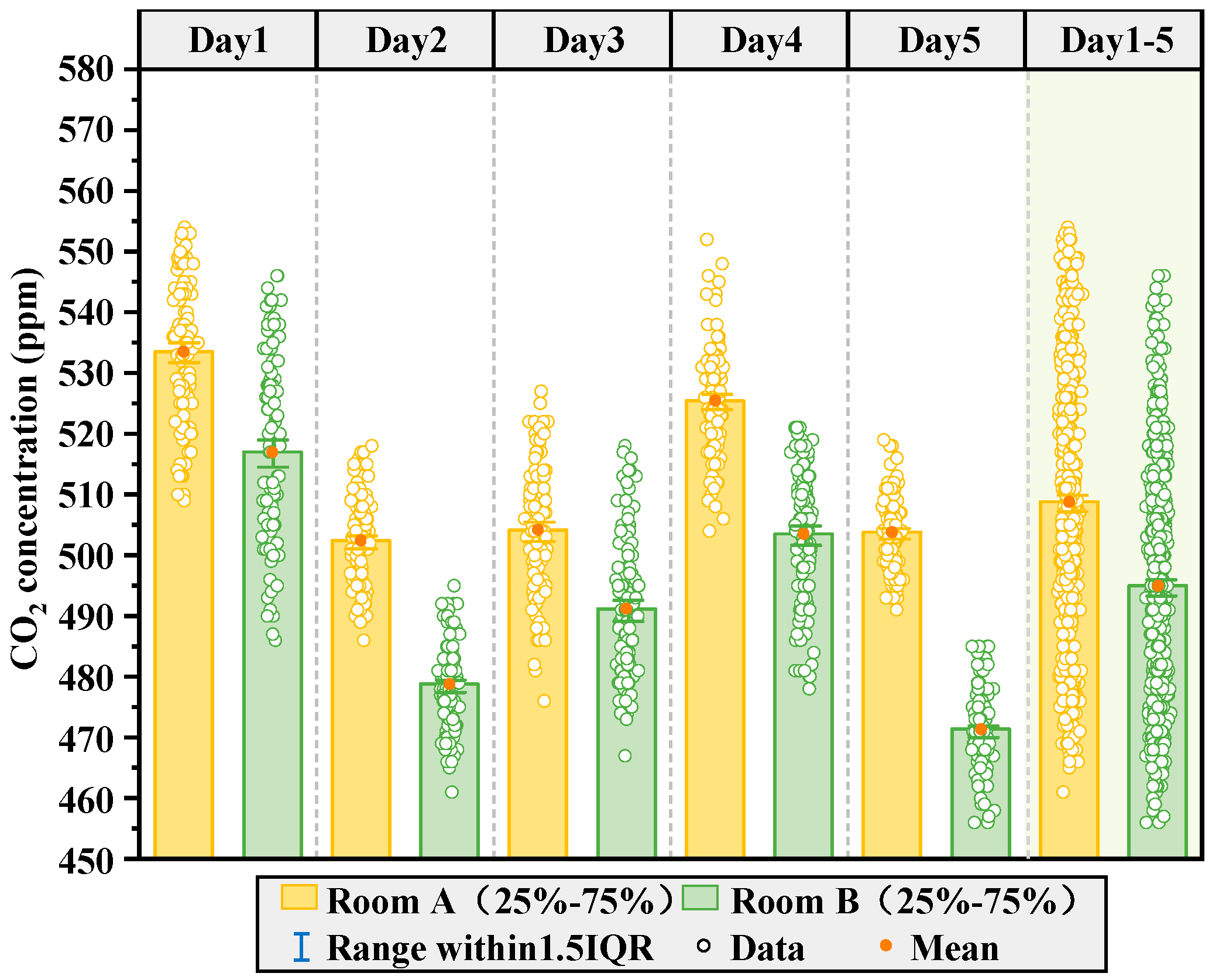
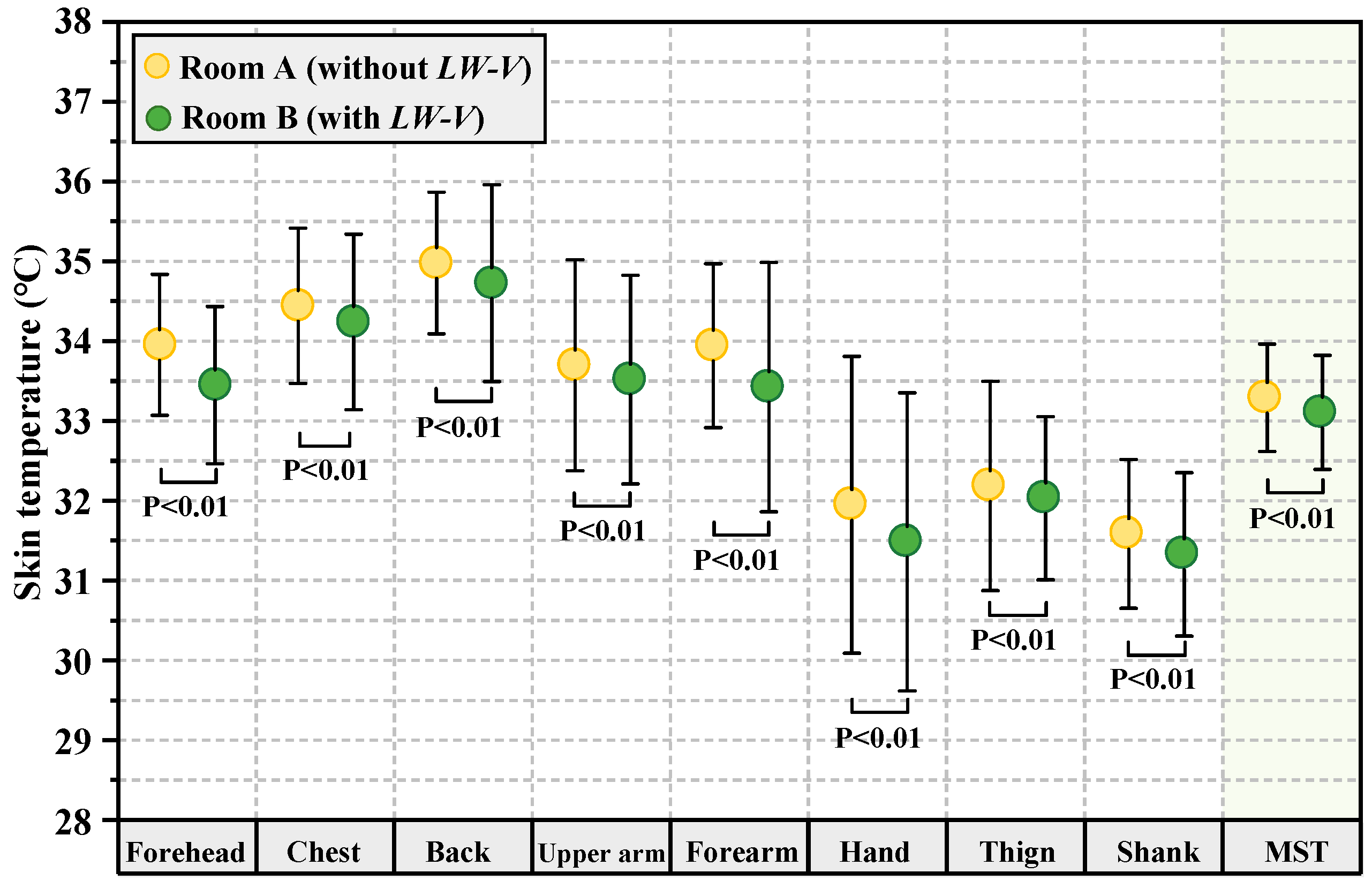

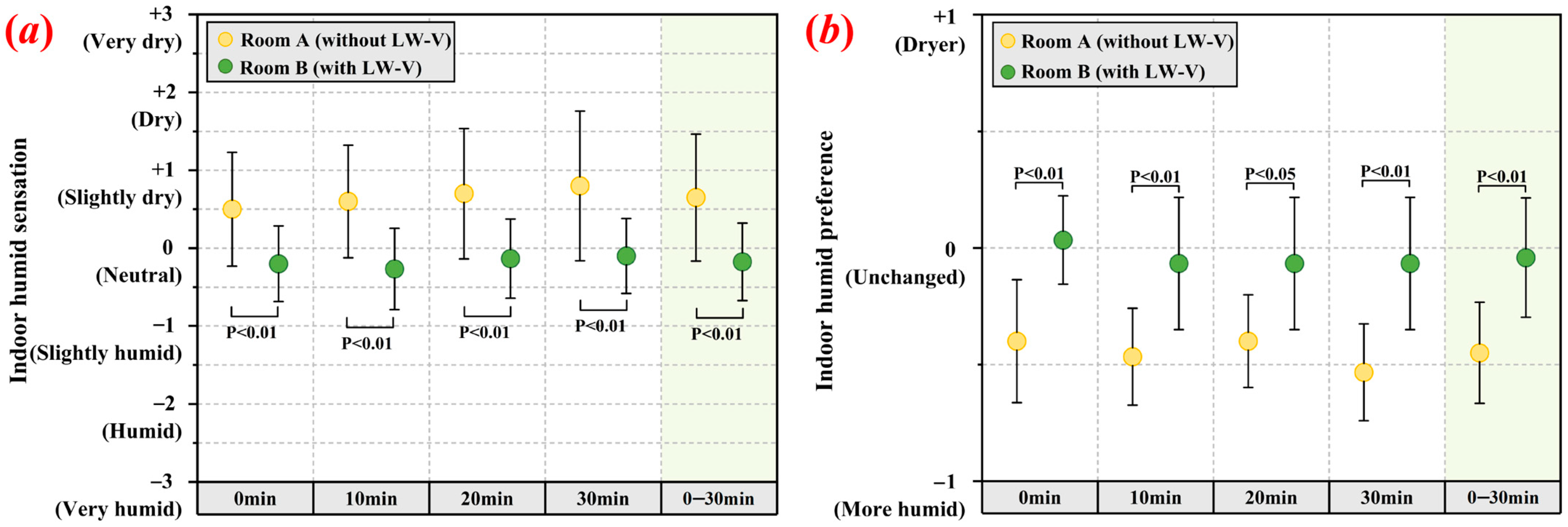
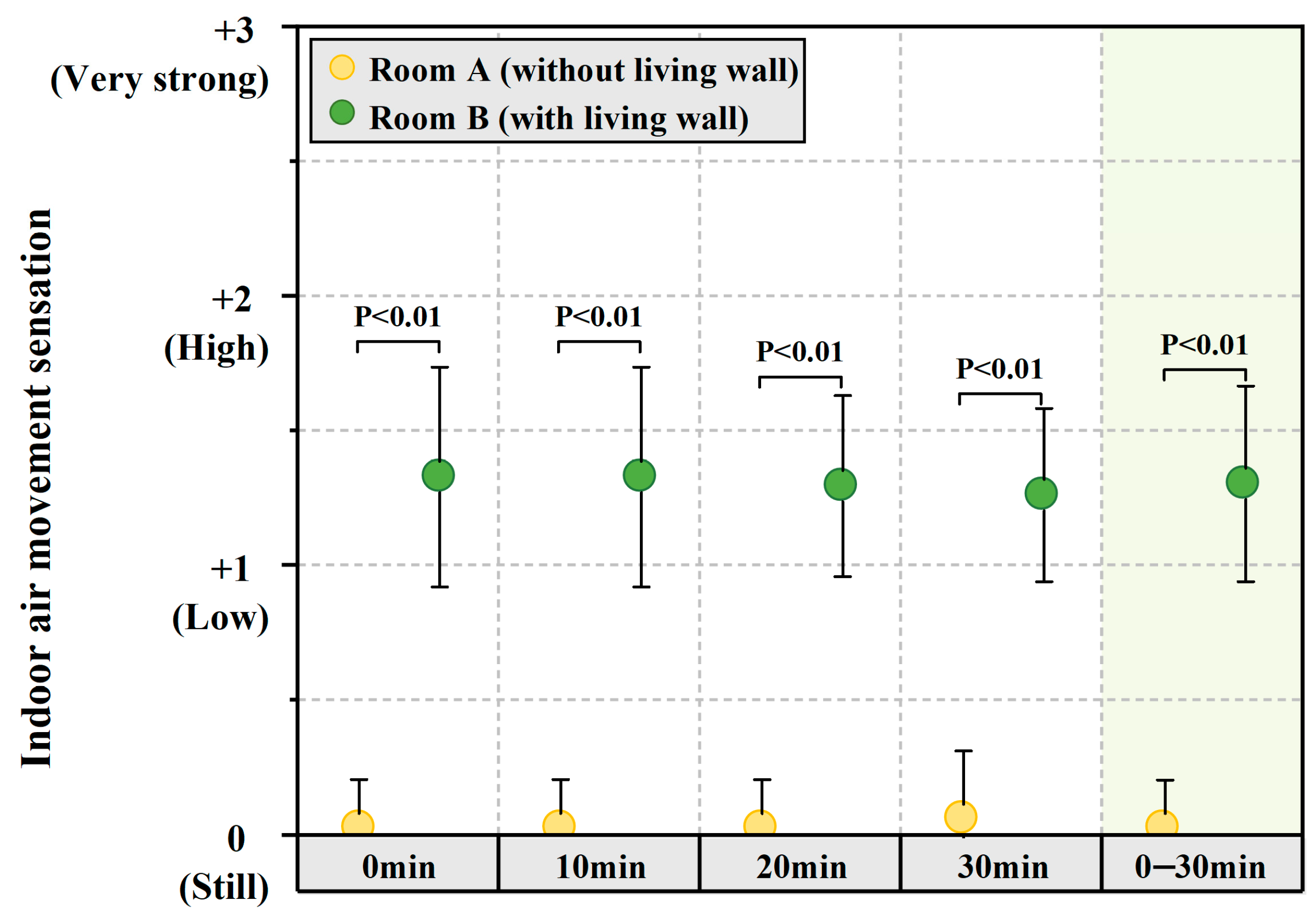
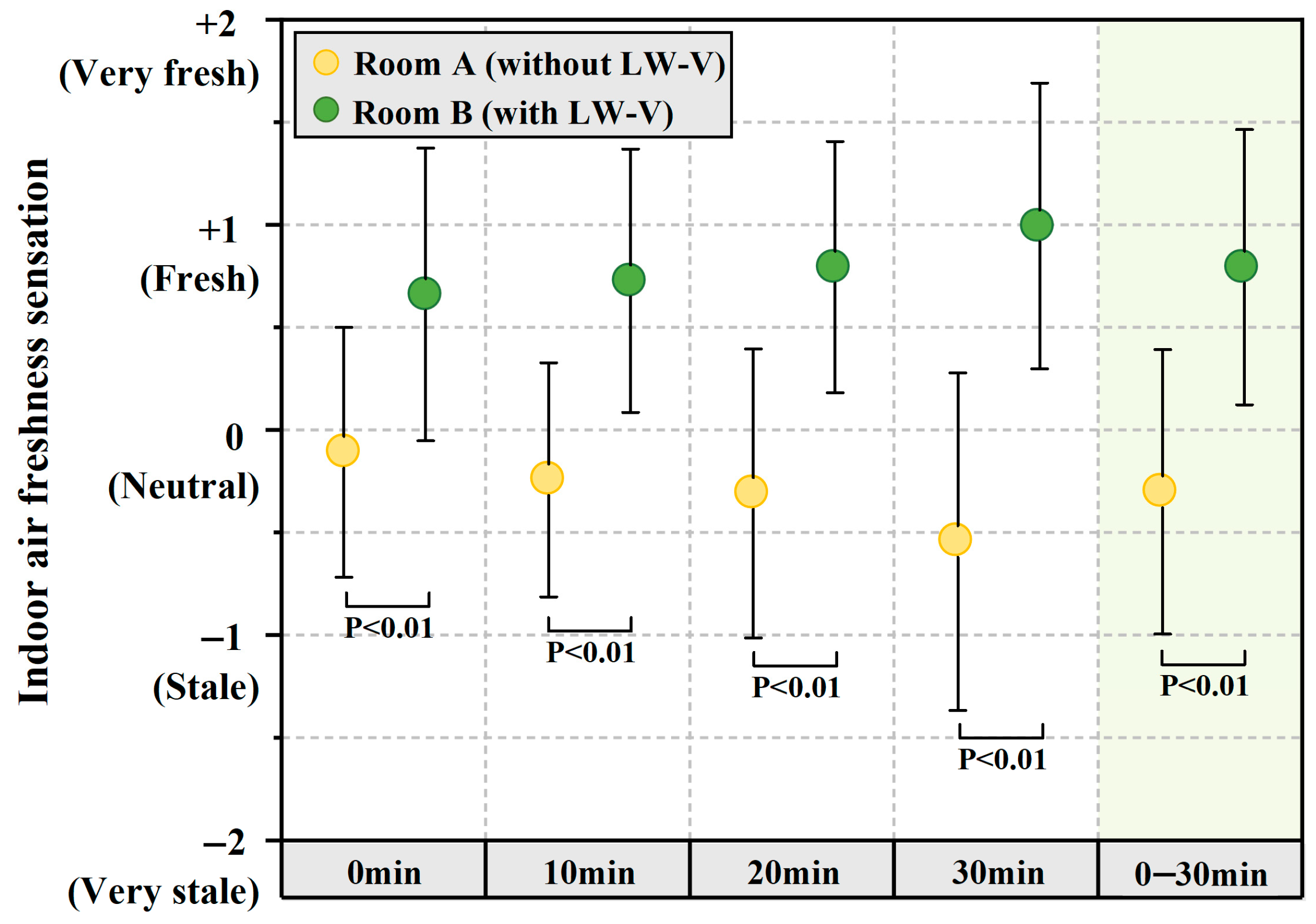
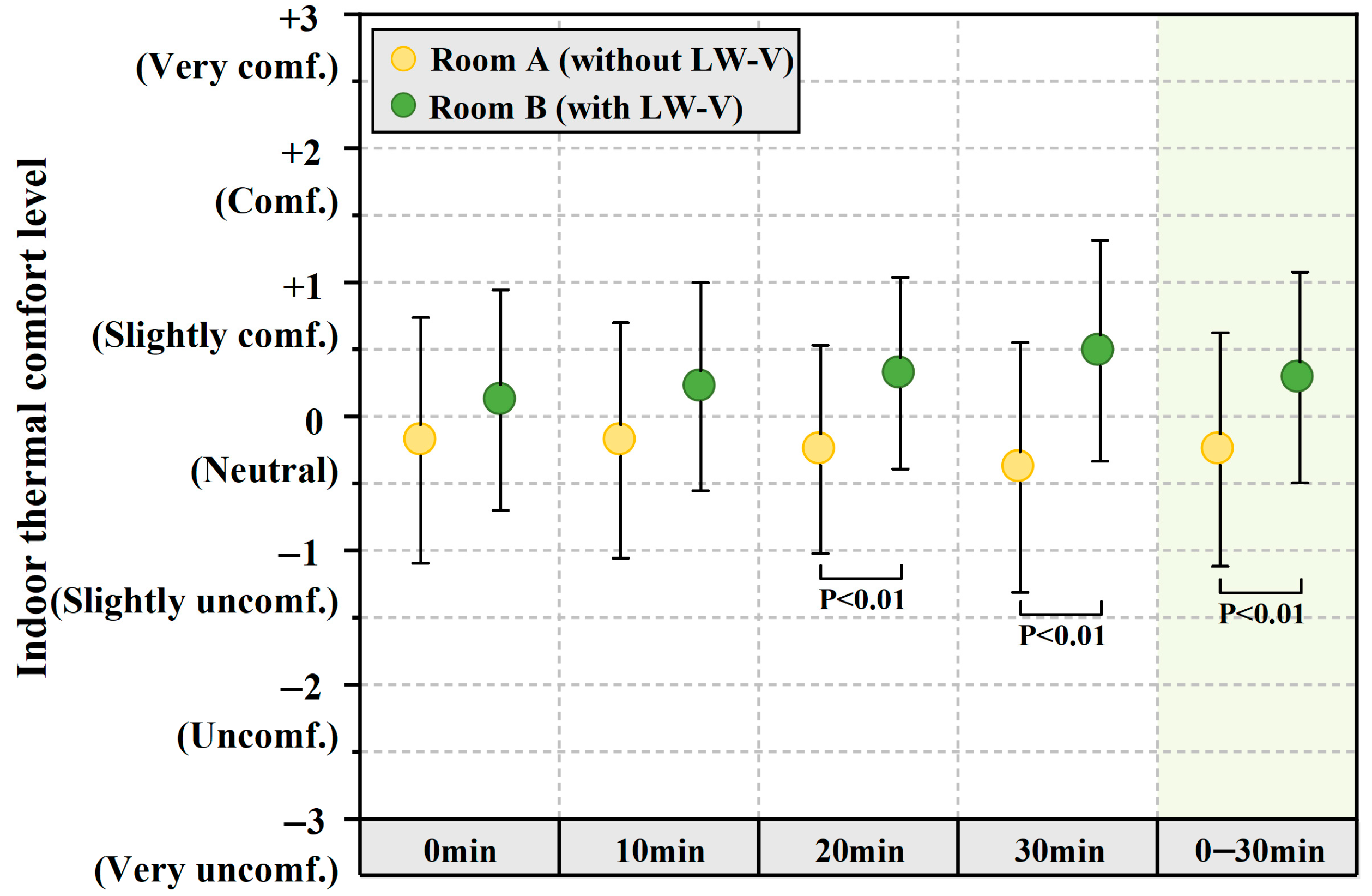

| Instrument | Model | Test Content | Range | Accuracy |
|---|---|---|---|---|
| Indoor thermal environment tester | JT-IAQ-50 | Air temperature | −20–120 °C | ±0.3 °C |
| Relative humidity | 0–100% RH | ±2% RH | ||
| Air speed | 0.05–2 m/s | ±0.03 m/s | ||
| Indoor environmental monitor | 3G19 | CO2 concentration | 400–5000 ppm | ±5% |
| Skin temperature monitor | ME103 (0.1) 3977V3B3000 | Skin temperature | 0–60 °C | ±0.1 °C |
| Scale | Thermal Sensation | Humid Sensation | Air Speed Sensation | Air Freshness Sensation | Thermal Comfort Level | Acceptance Level |
|---|---|---|---|---|---|---|
| +3 | Hot | Very dry | Very strong | - | Very comfortable | - |
| +2 | Warm | Dry | High | Very fresh | Comfortable | Very willing |
| +1 | Slightly warm | Slightly dry | Low | Fresh | Slightly comfortable | Willing |
| 0 | Neutral | Neutral | Still | Neutral | Neutral | Neutral |
| −1 | Slightly cool | Slightly humid | - | Stale | Slightly uncomfortable | Unwilling |
| −2 | Cool | Humid | - | Very stale | Uncomfortable | Very unwilling |
| −3 | Cold | Very humid | - | - | Very comfortable | - |
Disclaimer/Publisher’s Note: The statements, opinions and data contained in all publications are solely those of the individual author(s) and contributor(s) and not of MDPI and/or the editor(s). MDPI and/or the editor(s) disclaim responsibility for any injury to people or property resulting from any ideas, methods, instructions or products referred to in the content. |
© 2024 by the authors. Licensee MDPI, Basel, Switzerland. This article is an open access article distributed under the terms and conditions of the Creative Commons Attribution (CC BY) license (https://creativecommons.org/licenses/by/4.0/).
Share and Cite
Liu, F.; Meng, X. Integrating the Living Wall with Mechanical Ventilation to Improve Indoor Thermal Environment in the Transition Season. Sustainability 2024, 16, 4300. https://doi.org/10.3390/su16104300
Liu F, Meng X. Integrating the Living Wall with Mechanical Ventilation to Improve Indoor Thermal Environment in the Transition Season. Sustainability. 2024; 16(10):4300. https://doi.org/10.3390/su16104300
Chicago/Turabian StyleLiu, Fudan, and Xi Meng. 2024. "Integrating the Living Wall with Mechanical Ventilation to Improve Indoor Thermal Environment in the Transition Season" Sustainability 16, no. 10: 4300. https://doi.org/10.3390/su16104300
APA StyleLiu, F., & Meng, X. (2024). Integrating the Living Wall with Mechanical Ventilation to Improve Indoor Thermal Environment in the Transition Season. Sustainability, 16(10), 4300. https://doi.org/10.3390/su16104300






